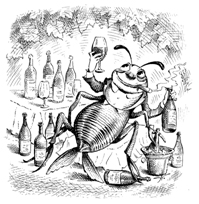Great pairing ideas for Oops Carmenere
Origin
The Carménère grape was originally planted in the Médoc region of Bordeaux, France, as far back as 1783 where it was used to produce deep red wines and occasionally used for blending because of its deep violet colour.
Carmenere is a member of the Cabernet family and the name originates from the French word for crimson (carmin) referring to the brilliant crimson colour of the autumn leaves.
 It is rarely found in France nowadays because of the phylloxera plague in 1867 that practically killed all the European vineyards.
It is rarely found in France nowadays because of the phylloxera plague in 1867 that practically killed all the European vineyards.
At this time, many immigrants from Europe moved to South America taking the Carmenere grape with them to grow in newly settled vineyards in Chile in the mid 19th century where it was grown freely with Merlot grapes.
In fact the Carmenere grapes were assumed to be Merlot until in 1997, viticulturist Jean Michel Boursiquot confirmed the mistake with the DNA of the grape.
Now Carmenere is grown primarily in Chile and is the country’s signature grape.
Oops: Why this name?
There’s a good reason the Merlot of Chile doesn’t taste like other Merlot. Many are not entirely Merlot, but instead a blend of Merlot and a far more exotic grape: Carmenère, a.k.a., The “Lost Grape of Bordeaux.” Carmenère root stock was transplanted from France over a century ago before the particularly nasty root louse threatened its very existence. Soon forgotten, the Carmenère grapes grew freely with Merlot grapes and were assumed to be Merlot until, suddenly in 1997, viticulturist Jean-Michel Boursiquot revealed the mistake with a DNA. Oops!

Carmenere and Merlot Tasting
Although Merlot and Carmenere grapes look alike, Carmenere is something in between Merlot and CS. Carmenere has great depth of deep-purple color, a jammy fruity aroma, and soft tannins just like Merlot, but it also has more complexity and earthiness like Cabernet. Today these same Carmenere grapes that have enhanced the Merlot of Chile for over 100 years add a distinctive style and character to all our oops wines.
Carmenère from Chile
Chile has become the new home of the Carmenere grape, and in particular, the Colchagua terroir has the largest surface area planted with this variety.
Thanks to central Chile’s minimal rainfall during the growing season and the protection of the country’s natural boundaries, growers produce healthy crops of Carménère.
Carmenere is a late ripening grape so it requires sunny dry days during the ripening season
Carmenere grapes are susceptible to root infection but Chile does not have phylloxera so it is able to grow well.
Difference between Carmenere in Chile and Bordeaux
Carmenere in Chile is more deeply coloured and sometimes more herbaceous than in its native Bordea
Matching Food and Wine
Oops carmenere Tasting Notes
The wine is deep purple-red in color, typical of this variety. Blackberry aromas are underscored by notes of ground white pepper, spices, and leather. Rich and mouth filling, black currant and plum flavors explode on the palate, with spice, herbs, and a long, soft finish. The tannins are surprisingly smooth and silky for a wine with such body and flavor
Carmenere Food Pairing
– Carmenere is a lovely red to drink in the spring when the weather is still a bit chilly. If you are not familiar with this grape, it is similar to its relative, Cabernet Franc but also reminiscent of Merlot with its rich plummy and spicy flavours.
– An excellent pairing for Carmenere would be fish such as seared tuna or seafood in general. Lamb is also delicious with this red, either rack of lamb or a middle eastern style lamb kebab or even a lamb curry.
– Since Carmenere has a smoky flavour to it, this wine would work well with bacon or barbecued ribs. In fact anything barbecued or grilled matches well with this delicious red.
– Meat Empanadas
– Grilled Vegetables like eggplant, zucchini, and asparagas are especially tasty with Carmenere

